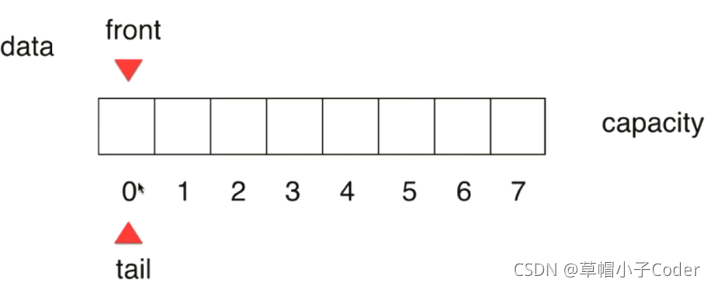2 队列
- 队列是一种先进先出的数据结构
- First in First out
2.1 数组队列的实现
Queue
- void enqueue(E),队尾添加数据,复杂度O(1)
- E dequeue(),队首去除数据,复杂度O(n)
- boolean isEmpty()
- int getSize()
2.2 定义队列接口
public interface Queue<E> {
int getSize();
boolean isEmpty();
void enqueue(E e);
E dequeue();
E getFront();
}
2.3 实现队列接口
public class ArrayQueue<E> implements Queue<E> {
private Array<E> array;
public ArrayQueue(int capacity) {
array = new Array<>(capacity);
}
public ArrayQueue() {
array = new Array<>();
}
@Override
public int getSize() {
return array.getSize();
}
public int getCapacity() {
return array.getCapacity();
}
@Override
public boolean isEmpty() {
return array.isEmpty();
}
@Override
public void enqueue(E e) {
array.addLast(e);
}
@Override
public E dequeue() {
return array.removeFirst();
}
@Override
public E getFront() {
return array.getFirst();
}
@Override
public String toString() {
return "ArrayQueue{" +
"array=" + array +
'}';
}
}
2.4 测试队列
public class Main {
public static void main(String[] args) {
ArrayQueue<Integer> arrayQueue = new ArrayQueue<>();
for(int i=0; i<10; i++) {
arrayQueue.enqueue(i);
System.out.println(arrayQueue);
if(i%3 == 2) {
arrayQueue.dequeue();
System.out.println(arrayQueue);
}
}
}
}
2.5 循环队列
为了降低数组队列移除队首数据时的复杂度,有人提出了循环队列。
- 队列为空



当循环队列为空时,队首指针front和队尾指针tail指向同一个位置,当循环队列不为空时,队首指针和队尾指针不再指向同一个位置。在队首移出数据或者队尾添加数据时,front和tail均会分别进行移动。
- 循环队列判空:front == tail
- 循环队列判满:(tail+1)% c == front (其中c为数组的长度)
- 循环队列会默认浪费一个空间
2.6 循环队列接口
public interface Queue<E> {
int getSize();
boolean isEmpty();
void enqueue(E e);
E dequeue();
E getFront();
}
2.7 循环队列的实现
import java.util.Arrays;
public class LooperQueue<E> implements Queue<E> {
private E[] data;
private int front,tail;
private int size;
public LooperQueue(int capacity) {
data = (E[]) new Object[capacity +1];
front = 0;
tail = 0;
size = 0;
}
public LooperQueue() {
this(10);
}
@Override
public boolean isEmpty() {
return front == tail;
}
@Override
public int getSize() {
return size;
}
public int getCapacity() {
return data.length - 1;
}
@Override
public void enqueue(E e) {
if((tail+1) % data.length == front) {
resize(getCapacity()*2);
}
data[tail] = e;
tail = (tail+1) % data.length;
size++;
}
@Override
public E dequeue() {
if(isEmpty()) {
throw new IllegalArgumentException("cannot dequeue");
}
E ret = data[front];
data[front] = null;
front = (front+1) % data.length;
size--;
if(size == getSize()/4 && getCapacity()/2!=0) {
resize(getCapacity()/2);
}
return ret;
}
public E getFront() {
if(isEmpty()) {
throw new IllegalArgumentException("queue is Empty");
}
return data[front];
}
private void resize(int newCapacity) {
E[] newData = (E[]) new Object[newCapacity + 1];
for(int i = 0; i<size; i++) {
newData[i] = data[(front+i)%data.length];
}
data = newData;
front = 0;
tail = size;
}
@Override
public String toString() {
return "LooperQueue{" +
"data=" + Arrays.toString(data) +
", front=" + front +
", tail=" + tail +
", size=" + size +
'}';
}
}
2.8 循环队列测试
public class Main {
public static void main(String[] args) {
LooperQueue<Integer> arrayQueue = new LooperQueue<>();
for(int i=0; i<10; i++) {
arrayQueue.enqueue(i);
System.out.println(arrayQueue);
if(i%3 == 2) {
arrayQueue.dequeue();
System.out.println(arrayQueue);
}
}
}
}
2.9 循环队列与数组队列的比较
循环队列的复杂度分析:
- void enqueue(E) O(1)
- E dequeue() O(1)
- E getFront() O(1)
循环队列在数组队列的基础上进行了优化,原因是由于数组队列的出队操作复杂度为O(n),循环队列借助于一个指针指向队首和队尾位置,不需要像数组队列一样,每次有数据出队时均需要将后面的数据往前挪动,可以很灵活的将数据出队。
下面是一段用于测试循环队列与数组队列在进行100000个数据入队和出队时所消耗的时间程序:
import java.util.Random;
public class Main {
public static void main(String[] args) {
int opCount = 100000;
//测试数组队列
ArrayQueue<Integer> arrayQueue = new ArrayQueue<>(opCount);
double time1 = testQueue(arrayQueue,opCount);
System.out.println(time1);
//测试循环队列
LooperQueue<Integer> looperQueue = new LooperQueue<>(opCount);
double time2 = testQueue(looperQueue,opCount);
System.out.println(time2);
}
public static double testQueue(Queue<Integer> q,int opCount) {
long startTime = System.nanoTime();
Random random = new Random();
//入队操作
for(int i = 0; i<opCount; i++) {
q.enqueue(random.nextInt(Integer.MAX_VALUE));
}
//出队曹组
for(int i = 0; i<opCount; i++) {
q.dequeue();
}
long endTime = System.nanoTime();
return (endTime - startTime) / 1000000000.0;
}
}
//测试结果,数组队列消耗21.797972269秒,循环队列消耗时间仅为0.013881263秒
21.797972269
0.013881263